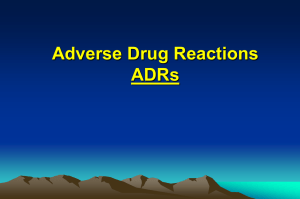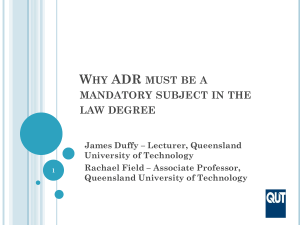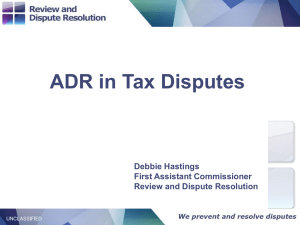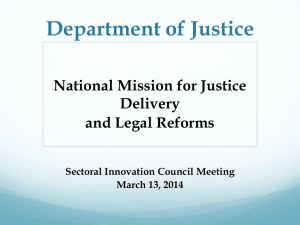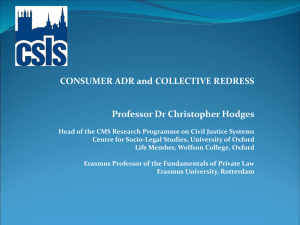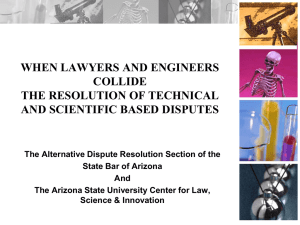Poly-pharmacy and Adverse Drug Reactions in the Elderly
advertisement
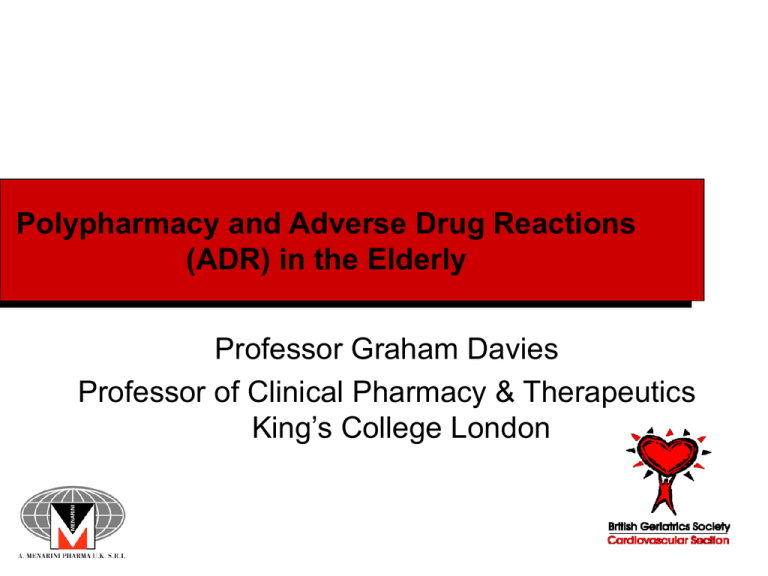
Polypharmacy and Adverse Drug Reactions
(ADR) in the Elderly
Professor Graham Davies
Professor of Clinical Pharmacy & Therapeutics
King’s College London
Content
Statistics and definitions
The risk of ADRs in the elderly
The ADR problem – the evidence
•
•
Causing hospital admission
Occurring in hospital
Challenges
•
•
Preventability
Managing the problem
Summary & questions
Level of performance
Lecturer
Audience
Time
Lloyd (1968)
“One of the greatest hazards is the use of
potent drugs is their inherent toxicity……
…..the dangers of the drug appear to be
greater now then ever before.”
David Barr MD; Hazards of modern diagnosis and therapy – the price we pay.
Frank Billings Memorial Lecture.
J Am Med Assoc 1955;159 (15): 1452-1456
In US:
ADR estimated to be between
th
th
4 and 6 leading cause of
death.
Lazarou JAMA
1998
For example…………NSAIDs Blower et al 1997 Aliment Pharmacol
Therap
12,000 admissions/yr 20 to GI bleed
2000 deaths/yr cf 3500 RTA
400 bed hospital working at capacity
Impact greater for >65 yrs:
– GI bleed,
– CHF
– Renal impairment
The statistics
In England:
Approx 20% population >60 years of age
Consume 56% of dispensed medicines
Costs around 40% of NHS drug budget
Growing ageing population
Definitions
Adverse Drug Events (ADEs)
‘any injury resulting from the use of drugs’
5 categories of ADEs:
1. Adverse drug reactions
2. Medication errors
3. Therapeutic failures
4. Adverse drug withdrawal events
5. Overdoses
Nebeker JR, Ann Intern Med. 2004;140(10):795-801
Risks from drug treatment
Adverse drug events
Medication errors
Adverse drug reactions
DEFINITION
“ADR is a response to a drug that is noxious and
unintended and occurs at doses normally used in
man for the prophylaxis, diagnosis or therapy of
disease, or for modification of physiological
function”
WHO. International drug monitoring: The role of the hospital. WHO Tech Rep.
1969; 425: 5-24
Classification
Type A
Type B
Predictable from P’cology
Unrelated to P’cology
Dose related
Poor relationship with dose
Influenced by kientic and
dynamic changes
Uncommon and difficult to
detect during development
Account for 75% of ADR
Patient idiosyncrasy major
factor
Preventable
Unavoidable
DEFINITION OF ADR
“An appreciably harmful or unpleasant reaction,
resulting from an intervention related to the use of a
medicinal product, which predicts hazard from
future administration and warrants prevention or
specific treatment, or alteration of the dosage
regimen, or withdrawal of the product ”
Edwards & Aronson. Adverse drug reactions: definitions, diagnosis, and
management. Lancet 2000; 356: 1255-59
DEFINITION
Edwards & Aronson. Lancet. 2000;356: 1255-59
Why are the elderly at risk of
ADRs?
Patient
Medicine
Environment
Physiological
Decline
Co-morbidities
PolyPharmacy
Cognitive
impairment &
adherence
Altered
Drug
Handling
Altered
Drug
Response
Pharmacogenetics
Adverse Drug
Reaction
Recovery,
Hospitalisation
Disability
Death
Pharmacokinetic changes in the elderly
Drug distribution
• changes in body fat/lean ratio & protein binding
• increase free drug concentrations (warfarin; phenytoin)
Metabolism
• changes to liver mass and blood flow
• decrease first pass metabolism - increase bioavailability
(opiates, nitrates)
Elimination
• Decrease clearance of renally excreted drugs (digoxin, lithium,
antibiotics)
• active metabolites – morphine-6-glucuronide
Patient
Medicine
Environment
Physiological
Decline
Co-morbidities
PolyPharmacy
Cognitive
impairment &
adherence
Altered
Drug
Handling
Altered
Drug
Response
Pharmacogenetics
Adverse Drug
Reaction
Recovery,
Hospitalisation
Disability
Death
Non-adherence to medicines
Three recent reports:
Estimated that between 30 -50%
medicines prescribed for long term
illnesses are not taken as directed
If prescription was appropriate then
this represents a loss for patients,
healthcare providers and pharma
industries
1World
Health Organization Report 2003.
2Horne
Effective interventions are elusive
3NICE.
(Haynes, et al. 1996, 2003 - series of Cochrane
reviews of efficacy of adherence interventions)
et al. Concordance, adherence and compliance
in medicine taking. NIHR SDO 2006.
Medicines concordance & adherence:involving
adults and carers in decisions about prescribed
medicines 2008/9
Patient
Medicine
Environment
Physiological
Decline
Co-morbidities
PolyPharmacy
Cognitive
impairment &
adherence
Altered
Drug
Handling
Altered
Drug
Response
Pharmacogenetics
Adverse Drug
Reaction
Recovery,
Hospitalisation
Disability
Death
ADRs and Age
Incidence of ADR increases with age
Elderly receive more medicines
Incidence of ADR increases the more
prescribed medicines taken (exponentially?)
Grymonpre et al (1988) – study >50 yrs
• ADR rates – 5% for 1 or 2 medicines
• Increased to 20% when >5 medicines
Table: The Prescribing Cascade
Initial treatment
Adverse effect
Subsequent
treatment
Subsequent
adverse effect
NSAIDs
Rise in blood
pressure
Antihypertensive
treatment
Orthostatic
hypotension
Thiazide diuretics
Hyperuricaemia
Allopurinol
Hypersensitivity
reaction (Skin
rashes)
Metoclopramide
treatment
Parkinsonian
symptoms
Treatment with
levodopa
Visual and
auditory
hallucination
(Source: Adapted from Rochon and Gurwitz, 1997)
The Evidence
Elderly not extensively studied
Usually part of general data-set
Homogeneity of studies a problem
The problem of homogeneity
Primary end points – ADE vs ADR
Definitions used
Method of identifying ADR (chart review vs
direct patient interview)
Assigning causality
Severity of harm
Preventability
Differ in:
•Algorithms & agreement
•Expert judgment
MAGNITUDE OF PROBLEM
Published studies relating to ADR
ADR causing hospital admission
ADR during inpatient stay
Systematic Review: ADRs in hospital patients
(Wiffen et al 2002)
Table: ADR by Clinical Setting (Wiffen et al 2002)
Impact of inpatient ADR (Wiffen et al 2002)
Cost – £380million/year to NHS England
Consuming 4% available bed-days
ADR causing hospital admission
Beijer & de Blaey. Pharm World Sci. 2002; 24(2):46-54
•Meta-analysis - 68 studies
•Hospitalisation of 6,071 pts ADR related (4.9%)
•ADR rate varied from 0.2% to 41.3%
•4 fold increase in ADR hospitalisation rate in
elderly (>65yr) compared to non-elderly
•88% of the ADR considered preventable in elderly
(vs 24% in non-elderly)
16.6%
4.9%
4.1%
More recently…(Pirmohamed et al BMJ 2004)
•Landmark UK study
•6 month Prospective study
•2 hospital: 1 teaching + 1 district hospital
•Medical and surgical wards
•Patients >16 years
ADR causing hospital admission
1. 6.5% of all admissions due to an ADR
2. Older patients more likely to be admitted with ADR
{76 yrs (65-83) vs 66 (46-79)}
3. 4% of hospital bed capacity
4. 0.15% fatality
5. Drug-interactions responsible for 1 in 6 ADRs
6. 72% were (possibly or definitely) preventable
7. Cost to NHS £466 million/year
Pirmohamed, M., et al. Adverse drug reactions as cause of admission to hospital:
prospective analysis of 18 820 patients. BMJ, 2004. 329(7456): 15-9.
“Older drugs continue to be the most commonly
implicated in causing admissions.”
Low dose aspirin 18% cases
Inpatient Elderly (Tangiisuran et al; Journal of Nutrition
Health and Ageing. 2009)
Prospective, observational design (6/12)
• ADR in the very elderly (≥80 years old)
• Preventability, severity and type of ADR
560 pts (mean 85 yrs; 63% female)
1 in 8 experienced ADR
• Majority serious (69%) some lifethreatening(4%). No deaths.
• 63% preventable
•
Drugs Causing ADR
Most frequent drug class
causing ADR
N
%
Cardiovascular active agents
Analgesics (opioid mainly)
Antibiotics
Hypoglycemic agents
Psychotropic agents
Anticoagulants
Others
28
15
12
8
6
4
10
34
18
15
10
7
5
12
Level of performance
Lecturer
Audience
Time
Preventability – implies original
decisions incorrect?
Rates vary:
54% (1998,US; >70yr)
28% (2003,UK; >75 yr)
72% (2004,UK; >16 yr)
56% (2009,UK; >16 yr)
63% (2009,UK >85 yr)
Review Preventability
2 panels (Doctors &
Pharmacists)
16 preventable cases
reviewed
Decision
Doctors P’cists
Remove
label
5
2
Change
decision
11
7
Closer
monitoring
0
7
16
16
Summary
ADR common – admission and during inpatient stay
Elderly more at risk
•
•
Range of factors – poly-pharmacy
Established medicines common cause
Drug’s Commonly Implicated
Drug
Common Issues
Antibiotics
Allergies & dosage adjustment in renal dysfunction
Anticoagulants
Bleeding; drug interactions, dynamic changes & environment
Cardiac glycosides
1 in 5 experience ADR, NTI & kinetic issues.
Diuretics
Dehydration, electrolyte imbalance
Hypoglycaemic agents (oral &
insulin)
Hypoglycaemia, changes to diet, poor monitoring
NSAIDs
GI bleed, renal impairment
Opioid analgesia
Sedation – dynamic and kinetic changes
Summary
ADR common – admission and during in-patient
stay
Elderly more at risk
•
•
•
Range of factors – poly-pharmacy
Established medicines common cause
Many preventable
If preventable – strategies for reducing ADRs?
Strategies
Identify patients – triggers
•
Vitamin K, creatinine changes, plasma
concentrations
Improve process of care (NSF stds?)
•
•
•
e-prescribing systems
Clinical pharmacists on rounds
Better communication across interface &
with patients (carers)
Strategies (cont.)
Predict at risk patients?
GerontoNet Study (NL,Belg,Italy,UK) (Arch Int Med)
483pts (mean 80yrs)
6 factors – score 8 or more = high risk
•
•
•
•
•
•
4+ Co-morbidities = +1
CCF = +1
Liver disease = +1
Renal impairment = +1
Previous ADR = +2
No of medicines = 5-7 = +1; >8 = +4
Prescribing to Reduce ADRs
Age, hepatic and renal disease may impair clearance of
drugs so smaller doses may be needed.
Prescribe as few drugs as possible and give clear
instructions to patients and carers
If serious ADRs are liable to occur warn the patient
Where possible use familiar drugs.
With new drugs be particularly alert for ADRs and
unexpected event.
Poly-pharmacy
and Adverse Drug
Reactions in the
Elderly
Graham Davies,
Professor of Clinical Pharmacy & Therapeutics,
King’s College, London
